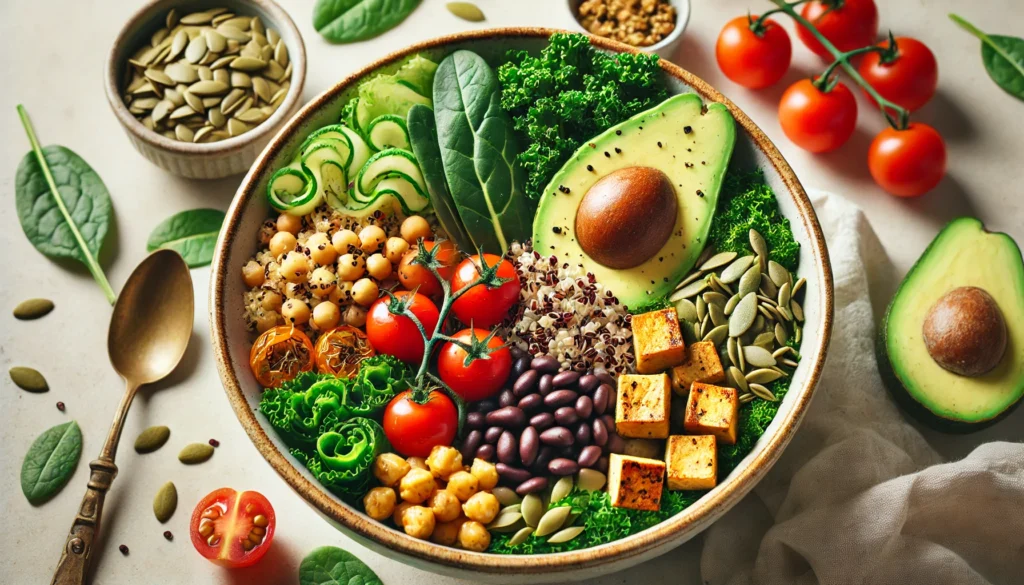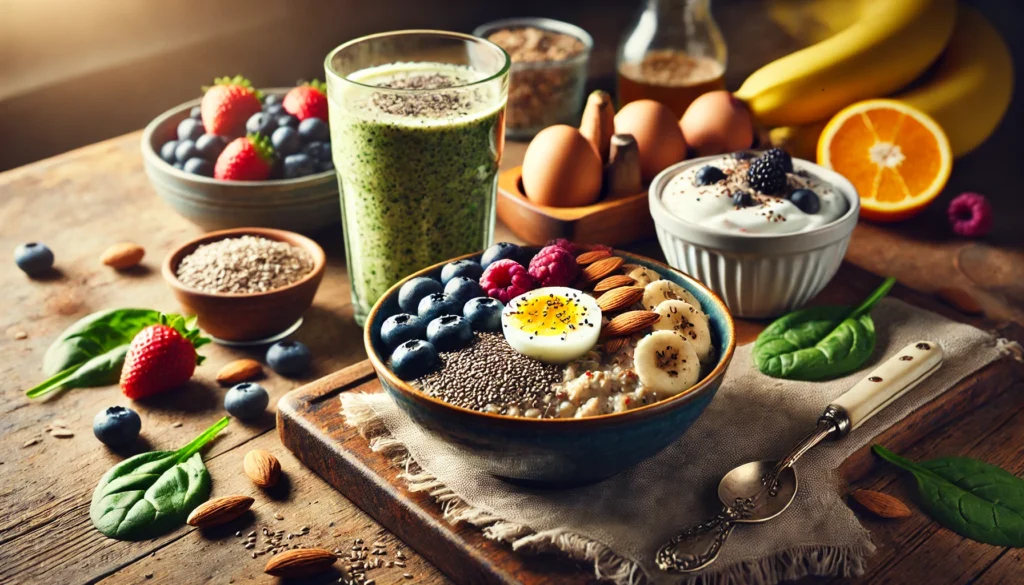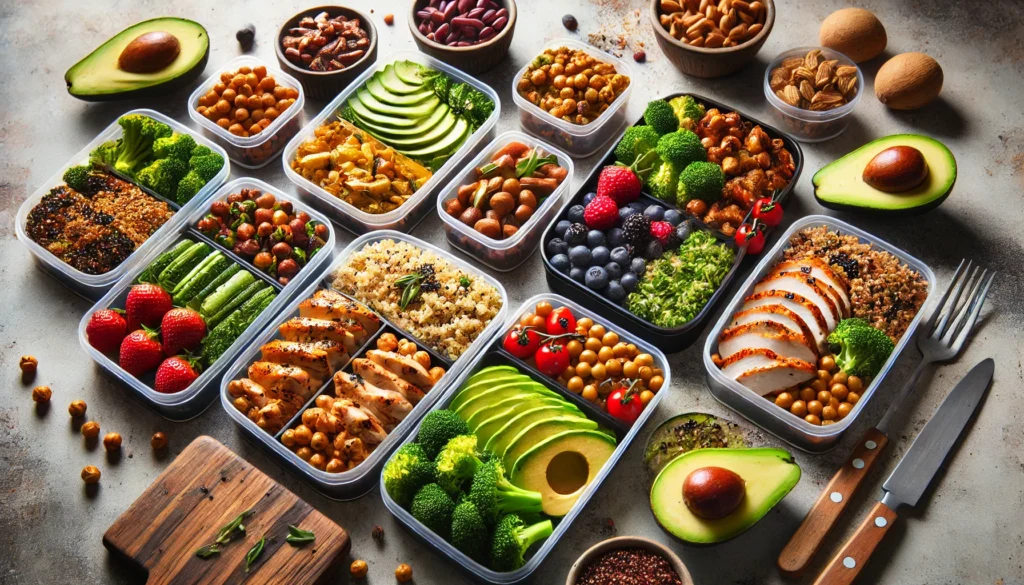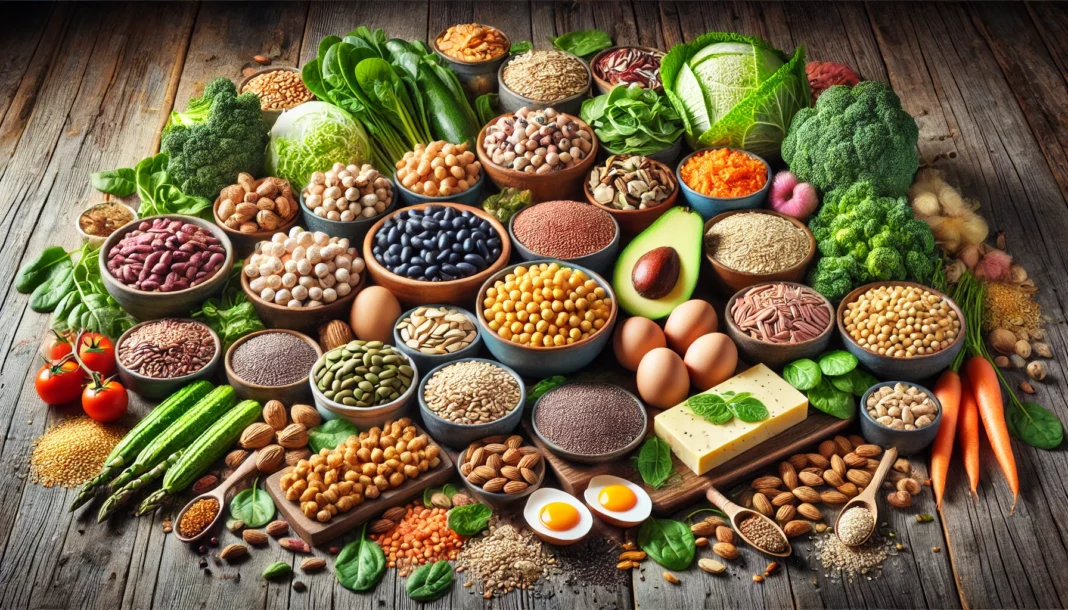Understanding the Importance of Protein and Fiber for Gut Health and Weight Loss
A well-balanced diet plays a crucial role in overall health, and incorporating foods high in protein and fiber can significantly enhance digestive function, support gut microbiome health, and promote sustainable weight loss. Protein is essential for muscle maintenance, metabolic function, and satiety, while fiber supports digestive health, stabilizes blood sugar levels, and fosters beneficial gut bacteria. When consumed together, these nutrients create a powerful synergy that not only helps individuals feel fuller for longer but also supports long-term weight management and overall well-being.
You may also like: Fiber and Microbiome: How Gut Health Impacts Athletic Recovery and Performance
Scientific research has consistently shown that diets rich in protein and fiber can help regulate appetite, reduce calorie intake, and improve metabolic health. The gut microbiome, which consists of trillions of microorganisms, thrives on fiber-rich foods that promote the growth of beneficial bacteria, leading to better digestion and enhanced immune function. Meanwhile, protein-rich foods help preserve lean body mass during weight loss, making them an essential component of any well-rounded diet. Understanding the highest sources of protein and fiber and their role in gut health is fundamental for optimizing nutritional intake and achieving lasting weight management success.
The Role of Protein in Gut Health and Weight Loss
Protein is a macronutrient that plays an integral role in maintaining the body’s structural and functional integrity. It is vital for muscle growth, tissue repair, enzyme production, and immune system support. A high-protein diet has been linked to increased satiety, reduced cravings, and improved weight loss outcomes by reducing overall caloric intake. Moreover, consuming protein-rich foods full of essential amino acids helps prevent muscle loss, particularly when individuals are in a calorie deficit for weight loss.
Beyond its benefits for weight management, protein also influences gut health. Studies suggest that amino acids derived from dietary proteins can impact gut microbiota composition and intestinal barrier integrity. Some protein sources, such as fermented dairy and plant-based proteins, contain bioactive peptides that contribute to gut health by promoting the growth of beneficial bacteria and reducing gut inflammation. However, it is important to choose high-quality protein sources, as excessive consumption of processed or red meats may negatively affect gut microbiota balance and contribute to digestive disorders.

The Significance of Fiber in Digestion and Satiety
Dietary fiber is an essential component of a healthy diet, particularly for those aiming to improve gut health and achieve sustainable weight loss. Fiber is classified into two main types: soluble and insoluble. Soluble fiber dissolves in water to form a gel-like substance that slows digestion and helps regulate blood sugar levels. This type of fiber is found in foods such as oats, legumes, apples, and flaxseeds. Insoluble fiber, on the other hand, adds bulk to stool and promotes regular bowel movements, reducing the risk of constipation and supporting overall digestive health.
Consuming fiber-rich foods can help manage body weight by increasing satiety and reducing total calorie intake. High-fiber diets have been shown to decrease hunger hormones while increasing levels of hormones associated with fullness. Additionally, fiber acts as a prebiotic, feeding the beneficial bacteria in the gut and fostering a balanced microbiome. A diverse and healthy gut microbiome is essential for optimal digestion, immune function, and metabolic health. Incorporating high-protein and fiber foods into daily meals is a practical strategy for enhancing gut health and promoting sustainable weight management.
The Best High-Protein and Fiber Foods for Gut Health and Weight Loss
Legumes: A Powerhouse of Protein and Fiber
Legumes, including lentils, chickpeas, black beans, and kidney beans, are among the highest sources of both protein and fiber, making them an ideal choice for a high-protein high-fiber diet. Lentils, for example, contain approximately 18 grams of protein and 15 grams of fiber per cooked cup, providing essential nutrients while promoting digestive health. The combination of protein and fiber in legumes contributes to prolonged satiety, reducing overall calorie intake and supporting weight loss.
Additionally, legumes are rich in resistant starch, a type of carbohydrate that resists digestion and acts as a prebiotic to feed beneficial gut bacteria. This helps improve gut microbiota diversity, which is crucial for a healthy digestive system and immune function. Consuming legumes regularly has been associated with a reduced risk of obesity, heart disease, and type 2 diabetes, making them an excellent staple for individuals looking to enhance their gut health and achieve long-term weight loss.
Nuts and Seeds: Nutrient-Dense Protein and Fiber Sources
Nuts and seeds are excellent sources of protein and fiber, as well as healthy fats, vitamins, and minerals. Almonds, chia seeds, flaxseeds, and pumpkin seeds, for instance, provide a balance of essential nutrients that support gut health and weight management. Chia seeds, for example, contain about 10 grams of fiber and 5 grams of protein per ounce, making them one of the highest protein and fiber foods available.
Nuts and seeds also contain polyphenols and omega-3 fatty acids, which have anti-inflammatory properties and support the integrity of the gut lining. Regular consumption of these nutrient-dense foods has been shown to improve satiety, reduce inflammation, and enhance metabolic function. Their high fiber content helps regulate digestion and supports a balanced gut microbiome, making them a valuable addition to a high-protein high-fiber diet for weight loss.
Vegetables: Fiber-Rich and Protein-Packed Options
While vegetables are not traditionally considered high-protein foods, several options provide a substantial amount of both protein and fiber. Broccoli, Brussels sprouts, spinach, and kale are among the highest protein and fiber vegetables, offering a wide range of vitamins, minerals, and antioxidants that contribute to overall health.
Cruciferous vegetables such as Brussels sprouts and broccoli contain fiber that promotes gut health and supports detoxification processes. These vegetables also provide a moderate amount of protein, making them valuable additions to a balanced fiber protein diet. Consuming a variety of fiber-rich vegetables ensures adequate nutrient intake and supports gut microbiota diversity, which is crucial for maintaining a healthy digestive system.

Frequently Asked Questions: High-Protein and Fiber Foods for Gut Health and Weight Loss
1. What are the best foods full of protein and fiber for gut health?
The best foods full of protein and fiber for gut health include a variety of plant-based and animal-based options that support digestion and nourish beneficial gut bacteria. Legumes such as lentils, chickpeas, and black beans are among the highest sources of both nutrients, offering a rich combination of soluble fiber and plant-based protein that aids digestion. Nuts and seeds, such as chia seeds, flaxseeds, and almonds, provide essential fatty acids along with fiber and protein, contributing to microbiome diversity. Whole grains like quinoa and oats are also excellent choices, as they contain resistant starches that serve as prebiotics, fostering the growth of good bacteria in the gut. Including a variety of these high-protein and fiber foods in your diet can promote digestive balance and enhance long-term gut health.
2. How does a high protein high fiber diet support weight loss?
A high protein high fiber diet supports weight loss by enhancing satiety, reducing overall calorie intake, and improving metabolic function. Protein is known to increase thermogenesis, meaning the body expends more energy digesting and metabolizing it compared to fats and carbohydrates. Fiber, particularly soluble fiber, slows digestion and stabilizes blood sugar levels, preventing spikes in hunger and cravings. Together, protein and fiber foods for weight loss help individuals feel full for longer, reducing the likelihood of overeating and snacking on less nutritious options. Over time, this balanced approach promotes fat loss while preserving lean muscle mass, ensuring sustainable weight management.
3. What are the highest sources of protein and fiber in plant-based foods?
Some of the highest sources of protein and fiber in plant-based foods include legumes, seeds, and whole grains. Lentils, which contain around 18 grams of protein and 15 grams of fiber per cooked cup, are among the best options for those following a plant-based diet. Quinoa, a complete protein containing all nine essential amino acids, provides a substantial amount of both protein and fiber. Chia seeds and flaxseeds, rich in omega-3 fatty acids, offer an excellent combination of dietary fiber and protein, supporting digestive health and inflammation reduction. Additionally, vegetables like spinach, kale, and Brussels sprouts contribute to overall nutrient density, making them essential additions to a high protein and fiber diet.
4. Does protein have fiber, or do they come from separate food sources?
Protein and fiber are distinct nutrients that typically come from separate food sources, though some foods naturally contain both. Most animal-based proteins, such as chicken, fish, eggs, and dairy, do not contain fiber, whereas plant-based protein sources, like beans, lentils, nuts, and seeds, provide both nutrients. Foods high in protein and fiber, such as quinoa and certain vegetables like broccoli, are particularly beneficial for overall health, as they support both muscle maintenance and digestive function. Combining protein-rich foods with fiber-dense options, such as pairing lean meats with whole grains or legumes, ensures a balanced intake that optimizes satiety and gut health. To achieve the benefits of both nutrients, it is essential to include a variety of whole, minimally processed foods in your diet.
5. Are there high protein high fiber low calorie foods for weight loss?
Yes, several high protein high fiber low calorie foods can be incorporated into a weight loss-focused diet. Lentils, black beans, and chickpeas provide a powerful combination of protein and fiber while being low in fat and calorie-dense nutrients. Leafy greens like spinach and kale, while not exceptionally high in protein, offer fiber and essential micronutrients with very few calories. Quinoa and oats are excellent grain options that deliver protein and fiber without excessive calorie content, making them ideal for weight management. Non-fat Greek yogurt paired with high-fiber foods such as berries or flaxseeds creates a nutrient-dense meal that supports satiety and metabolic health. By selecting nutrient-dense, low-calorie foods, individuals can maintain a calorie deficit while still receiving essential macronutrients.
6. How does fiber protein diet impact gut microbiome health?
A fiber protein diet positively impacts gut microbiome health by nourishing beneficial bacteria and promoting balanced digestion. Fiber, especially from whole foods, acts as a prebiotic that feeds gut bacteria, helping to maintain a diverse and resilient microbiome. Protein, particularly from plant-based sources, contains amino acids that influence gut barrier integrity and support anti-inflammatory pathways in the digestive system. Consuming a variety of high protein and fiber foods ensures that different types of gut bacteria receive the nutrients they need to thrive. Fermented protein-rich foods, such as tempeh and kefir, offer additional probiotics that contribute to microbiome diversity and overall gut resilience. A well-rounded diet that includes fiber and protein sources supports digestive efficiency, immune function, and long-term gut health.
7. What are the best protein and fiber foods for weight loss meal planning?
For effective weight loss meal planning, focusing on a balance of protein and fiber foods is essential for satiety and nutrient intake. Breakfast options such as oatmeal with chia seeds and Greek yogurt provide a strong foundation of protein and fiber. Lunches incorporating quinoa, black beans, and avocado supply essential fats, fiber, and plant-based proteins to keep energy levels stable. Dinners featuring lean proteins like grilled chicken or tofu with roasted vegetables and whole grains ensure a filling yet calorie-conscious meal. Snacks such as hummus with raw vegetables or a handful of almonds can prevent hunger between meals while providing essential nutrients. Integrating a variety of high protein and fiber foods into daily meals enhances metabolic function and promotes sustainable weight loss.
8. Are there potential drawbacks to a high protein and fiber diet?
While a high protein and fiber diet is beneficial for most individuals, some may experience digestive discomfort if they drastically increase fiber intake too quickly. Excessive fiber consumption without adequate hydration can lead to bloating, gas, and constipation. Additionally, consuming very high protein amounts without sufficient carbohydrate intake may strain kidney function in individuals with pre-existing conditions. Balancing a fiber protein diet by gradually increasing fiber intake and ensuring adequate water consumption can help prevent digestive issues. Consulting a healthcare provider or nutritionist can provide personalized recommendations for maintaining an optimal protein and fiber balance.
9. How do the highest protein and fiber foods compare in terms of nutrient density?
The highest protein and fiber foods vary in their overall nutrient profiles, making it essential to include a variety of sources for a well-rounded diet. Legumes such as lentils and chickpeas are rich in iron, folate, and magnesium, in addition to their protein and fiber content. Nuts and seeds provide heart-healthy fats and essential minerals, making them nutrient-dense choices for overall wellness. Whole grains like quinoa and oats supply complex carbohydrates and B vitamins that contribute to sustained energy and metabolic function. While each category of protein and fiber foods has unique benefits, combining different sources ensures a diverse intake of vitamins, minerals, and antioxidants for overall health.
10. Can high protein and fiber foods improve blood sugar regulation?
Yes, high protein and fiber foods play a critical role in blood sugar regulation by slowing the absorption of glucose into the bloodstream. Soluble fiber in foods such as oats, beans, and flaxseeds forms a gel-like substance in the digestive tract, reducing the rate at which sugars are released into the bloodstream. Protein further stabilizes blood sugar by slowing digestion and enhancing insulin sensitivity, which helps prevent rapid spikes and crashes. A high protein high fiber diet for weight loss can be particularly beneficial for individuals with insulin resistance or type 2 diabetes. By incorporating balanced meals with protein and fiber, blood sugar levels remain more stable, reducing cravings and promoting sustained energy throughout the day.

Whole Grains: A Sustainable Source of Protein and Fiber
Whole grains, including quinoa, brown rice, oats, and barley, are excellent sources of both protein and fiber. Quinoa, for instance, is one of the few plant-based complete proteins, providing all nine essential amino acids along with a high fiber content. Oats contain beta-glucans, a type of soluble fiber that helps regulate blood sugar levels and supports gut health.
Incorporating whole grains into a high-protein high-fiber diet for weight loss helps maintain steady energy levels and reduces cravings by promoting prolonged satiety. Additionally, whole grains serve as a source of resistant starch, which functions as a prebiotic and nourishes beneficial gut bacteria. Choosing whole grains over refined grains can significantly improve digestive health, reduce inflammation, and support long-term weight management.
Further Reading:
22 High Fiber Foods You Should Eat
7-Day High-Protein, High-Fiber Anti-Inflammatory Meal Plan, Created by a Dietitian
Which foods contain the most fiber?
high fiber meals, protein-packed foods, fiber-rich nutrition, gut-friendly diet, best foods for digestion, weight loss superfoods, fiber and protein synergy, healthy eating habits, plant-based protein sources, gut microbiome support, best foods for satiety, natural weight management, fiber for gut health, protein for metabolism, whole food nutrition, prebiotic foods, digestive wellness, muscle maintenance diet, high-fiber meal planning, balanced macronutrients
The information contained in this article is provided for general informational purposes only and is not intended to serve as medical, legal, or professional advice. While NewsHealthWatch strives to present accurate, up-to-date, and reliable content, no warranty or guarantee, expressed or implied, is made regarding the completeness, accuracy, or adequacy of the information provided. Readers are strongly advised to seek the guidance of a qualified healthcare provider or other relevant professionals before acting on any information contained in this article. NewsHealthWatch, its authors, editors, and contributors expressly disclaim any liability for any damages, losses, or consequences arising directly or indirectly from the use, interpretation, or reliance on any information presented herein. The views and opinions expressed in this article are those of the author(s) and do not necessarily reflect the official policies or positions of NewsHealthWatch.

